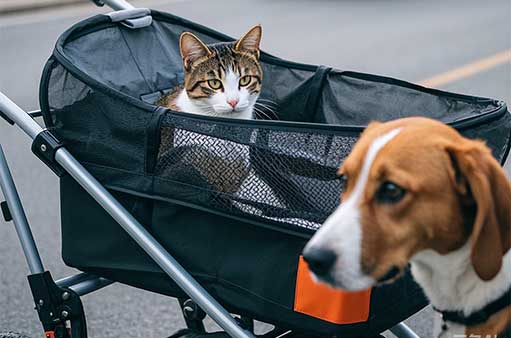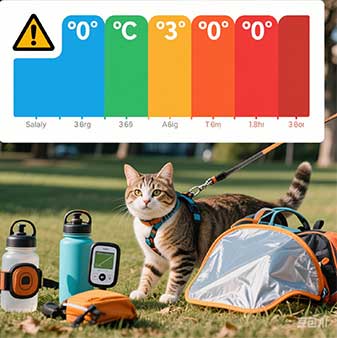多くの猫の飼い主にとって、猫の友達を 猫用ベビーカー 安全性と屋外でのエンリッチメントのバランスが完璧に見えるかもしれません。しかし、猫はベビーカーが好きなのでしょうか?答えは簡単ではありません。ベビーカーを気に入っている猫もいれば、納得してもらうのに苦労する猫もいます。この包括的なガイドは、あなたの猫にベビーカーが合っているかどうか、そして飼い主と猫の両方にとって楽しい体験にする方法を見つけるのに役立ちます。
猫用ベビーカーを選ぶべき理由とは?主なメリットを解説
猫用ベビーカーには、ただかわいいというだけではなく、数多くの利点があります。
安全なアウトドアアドベンチャー
リードをつけて歩く場合とは異なり、ベビーカーを使用すると、交通、攻撃的な犬、潜在的な捕食者から猫を完全に保護しながら、新鮮な空気を楽しむこともできます。
精神刺激
『Journal of Feline Medicine and Surgery』の新しい研究によると、室内飼いの猫は、屋外に制御的に出ることでストレスや退屈が大幅に軽減されるそうです。
特別なニーズへのソリューション
最適な用途:
- 運動機能に問題のある高齢の猫
- 障害のある猫
- 手術後の回復
- ハーネスを嫌がる不安な猫
旅行が簡単になりました
ベビーカーは、ストレスの多い獣医への通院を穏やかな外出に変え、ペット連れの休暇をより管理しやすいものにします。
猫のベビーカー反応の読み方
ベビーカーを導入する際には、猫のボディランゲージを理解することが重要です。
明るい兆候
- 耳は前を向き、ひげはリラックスしている
- 好奇心旺盛な嗅覚と環境スキャン
- 喉をゴロゴロ鳴らしたり、体をこねたりする行動
- ベビーカーへの自発的な乗り込み
ストレス指標
- 耳が平らになったり、瞳孔が広がったりする
- 過度の発声や息切れ
- 逃げたり隠れたりしようとする
- 尻尾を折り曲げた低い姿勢
プロのヒント:
まずは5分間の室内での散歩から始めて、その後屋外での散歩へと進みましょう。常に猫のペースに任せましょう。
猫用ベビーカーのトレーニングガイド(ステップバイステップ)
1: 慣熟(1日目~3日目)
- 開いたベビーカーを猫のお気に入りの部屋に置く
- 通常の寝具と一緒に敷きます
- 探索を促すためにキャットニップを撒いたり、おやつを入れたりしましょう
2: ポジティブな連想(4~7日目)
- ベビーカーの近くで食事を提供し、ボウルを徐々にベビーカーの中に移動させます
- インタラクティブなおもちゃを使って楽しい体験を作りましょう
- 不安を軽減するためにフェロモンスプレーを検討する
3:運動導入(8日目~14日目)
- ベビーカーに座ったまま動かないようにする
- 穏やかな揺れの動きへと進む
- 最終的には、滑らかな床を短距離で押す動作を試してみましょう
4: 屋外入門(第3週以降)
- 静かな時間(夜明け/夕暮れ)を選ぶ
- 近所を5分ほど散歩することから始めましょう
- 快適さに応じて徐々に時間を増やします
重要なリマインダー: 怯えている猫には決して無理強いしないでください。2~3週間経っても苦痛の兆候が続く場合は、別のエンリッチメント方法を検討してください。
脱出防止設計 - ダブルジッパーと安全なラッチを探してください
適切な換気 - メッシュパネルは側面の少なくとも50%を覆う必要があります
サスペンションシステム - 不均一な路面でのスムーズな走行に重要
重量容量 - 猫のサイズとアクセサリーに対応できることを確認してください

常にハーネスで猫を固定してください
水と折りたたみ式のボウルを持ち歩く
散歩前に路面温度をチェックする
心地よさのために、なじみのある匂いのアイテムを持っていく
猫を放っておく(たとえ「ほんの1分」でも)
交通量の多い道路や騒音の大きい工事現場の近くを歩く
猫が苦痛を示している場合は、使用を続行してください
天候保護(レインカバー/サンシェード)は忘れてください
安全ハック: セキュリティを強化するために、ベビーカーに AirTag または GPS トラッカーを取り付けます。
猫がベビーカーを拒否する場合は、次のオプションを試してください。
ハーネストレーニング - 自信のある猫に最適(15分間の室内セッションから始めましょう)
猫のバックパック - 不安な猫にとって、囲まれた空間はより安全だと感じることが多い
キャティオス - 屋外の囲いは、移動のストレスなく新鮮な空気を提供します
窓の止まり木 - 視覚刺激のためのシンプルなソリューション
覚えておいてください:約30%の猫はベビーカーに慣れませんが、それは問題ありません!室内でのエンリッチメントも同様に効果的です。
何百人もの猫の飼い主と仕事をした結果、ベビーカーの成功は次の要素にかかっていることがわかりました。
あなたの猫の性格 - 大胆な探検家は最も早く適応する
何百人もの猫の飼い主と仕事をした結果、ベビーカーの成功は次の要素にかかっていることがわかりました。
あなたの猫の性格 - 大胆な探検家は最も早く適応する
適切な紹介 - 急ぐと挫折する
現実的な期待 - すべての猫が気に入るわけではない
散歩に慣れた人にとって、そのメリットは否定できません。あるお客様は、以前は不安だった猫が、定期的にベビーカーで散歩に出かけるようになってから自信を取り戻したと報告しています。また別のお客様は、動物病院への通院が、トラウマから耐えられるものに変わったと報告しています。
あなたの番: 猫用ベビーカーを試したことはありますか?あなたの猫ちゃんにとって効果的だったこと(あるいはそうでなかったこと)を、ぜひ下の欄でシェアしてください。猫のケアに関するヒントをもっと知りたい方は、室内での猫のエンリッチメントに関するアイデアガイドをご覧ください!